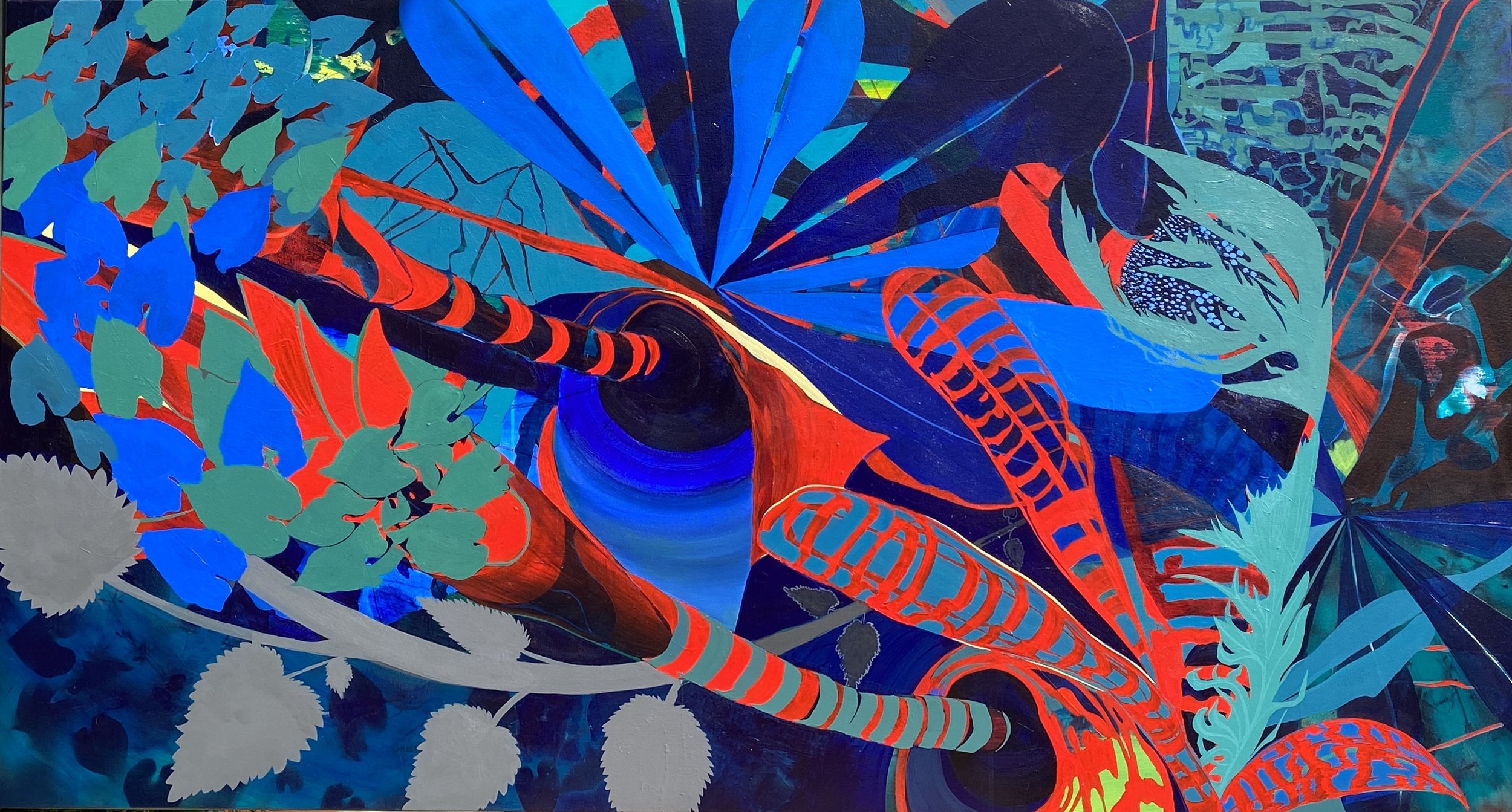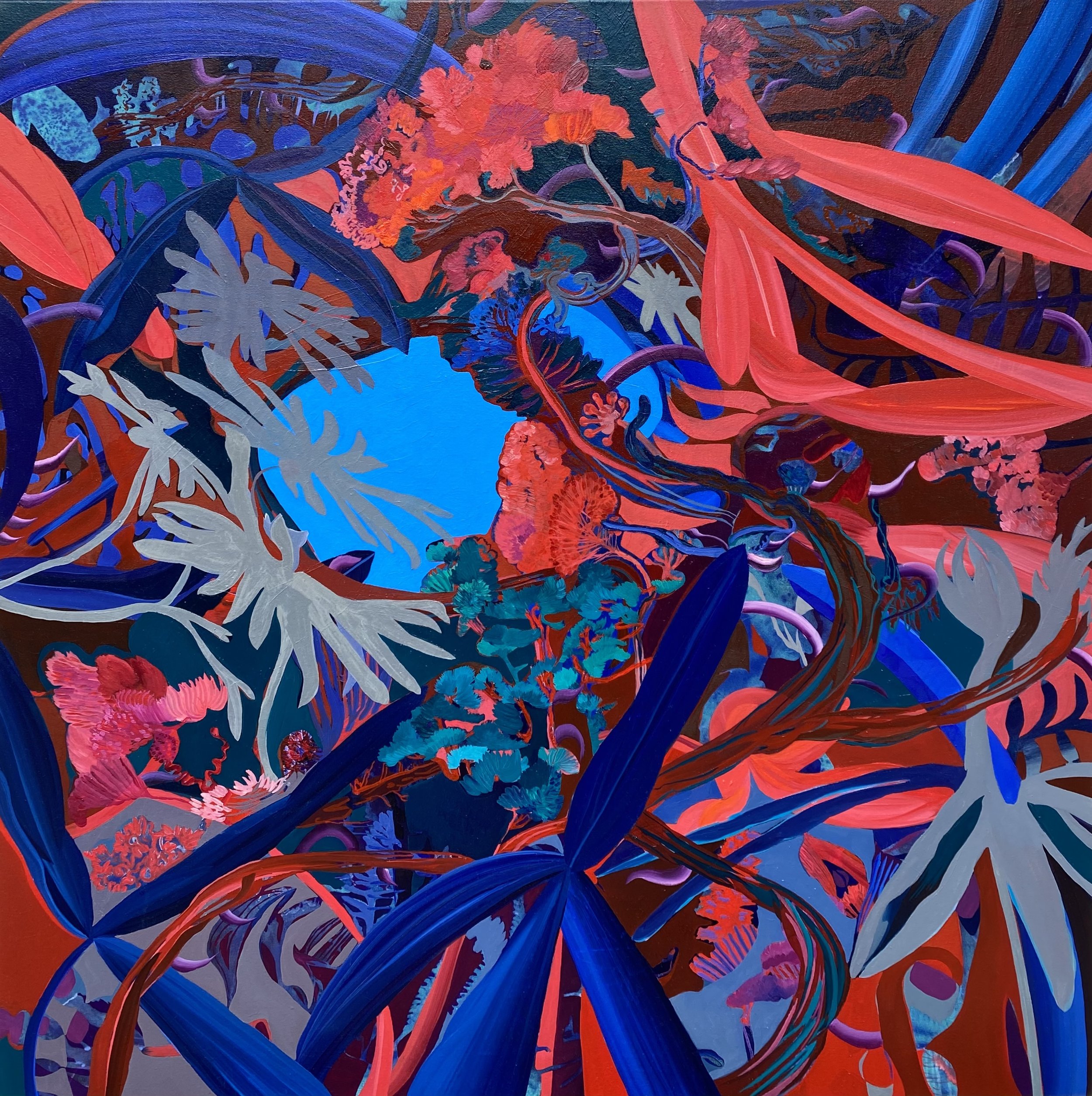Nick Aston
Nick Aston is a visual artist whose sought after work provides pictorial windows into visually rich botanic realms where plants are unapologetic protagonists.
Responding to an historical artistic tradition of representing and celebrating plants purely as passive aesthetic and planted gardens as a marvel of human control over nature, Nick’s work explores how plants can be understood in terms of power, agency, ambiguity and the future. Having completed a MA Fine Art Painting at the University of Arts London (distinction), Nick lives in Hampshire in the UK, where he uses acrylic, oil and spray paint to represent how plants are often arranged artificially, whether in botanic gardens, planted landscapes or as pressed specimens fixed on herbarium sheets.
Adopting a stylized approach that heightens the unnaturalness of how plant life can be organized through human interventions into the plant kingdom, Nick’s work mobilises concepts such as heterotopia, a space characterised by incompatible juxtapositions that can produce ambiguity and disturbance.
Botanic heterotopias such as botanic and planted gardens are recurring contexts in Nick’s work, wherein humans and plants co-exist, interact and collaborate with each other. Many of his paintings explore the ambiguous effects this can produce, such as the visual confusion from observing plants that would not grow together in nature,
Aspects of Nick’s studio practice engages with plants understood as ‘weeds’ and ‘aliens’, as plants worthy of pictorial representation in their own right but whose occupation in the tradition of botanically themed art work has often been marginal or omitted altogether.
This can be seen in work where weeds are centre stage, often painted larger than life and rendered in highly saturated colour palettes to give them a far nobler status and prominent position. Rooted in and inspired by this diversity in the plant kingdom, Nick’s work creates botanic realms that are visibly rich, lush and luminous, enabling the viewer to immerse themselves in plant dominated worlds or ‘botaniscapes’.
Overall, Nick’s work collaborates with the viewer, encouraging them to see beyond the literal figurative references to plants and gardens they may already be familiar with.
Could you tell us a little more about your background and how you began creating art?
I have been driven by a need to paint since I was a child, inspired back then as I am today by the life of plants in all its splendour and vitality. My early curiosity and fascination with plants compelled me to fill up sketchbooks with line drawings and paintings of plants in the wild, and, later, create linocut prints based on pressed plant specimens. Although I wanted a career in the visual arts, I worked as an academic in the social sciences before events in my life enabled me to find the space I needed for my artistic expression to develop. Completing a MA in Fine Art Painting at University of Arts London, UK, helped me to work as a professional visual artist. Also, it provided opportunities for me to experiment with different ideas (e.g. drawn from critical plant studies) and media (e.g. spray, acrylic and oil paints), in order to create paintings that prioritize plants as participants and architects of their botanical worlds. As such, I do not limit myself to using one painting medium; rather, my studio practice embraces the distinctive qualities that specific paints offer.
What does your art aim to say to its viewers?
My artwork aims to collaborate with its viewers, encouraging them to see beyond the literal figurative references to plants and gardens they may already be familiar with. My work seeks to create visual languages that can represent plant worlds – or botaniscapes as I call them - that are visibly rich, lush and contain contradictory elements, which may produce visual confusion and fascination from observing diverse plant species alongside each other, in ways that are not replicated in the natural world. I hope some of my work permits viewers to question the limitations of how plant life is currently perceived, revealing insights into how plants are not merely objects of human consumption but are dynamic participants in the world that oblige us to rethink our relationships with them. For example, some paintings engage with plants understood as ‘weeds’ and ‘aliens’, not as undesirable plant matter but as noble plants worthy of pictorial representation in their own right, but whose occupation in the tradition of botanically themed art work has often been marginal or omitted altogether.
'As such, the viewer is invited to comprehend the limitations of our current perceptions of plant life. Emphasizing the active presence plants have in worlds humans have created, in paintings that visualize vegetal being, the viewer is compelled toward speculative futures that meditate on the connections between plants and humans.'
Can you tell us about the process of creating your work? What is your daily routine when working?
I work most days and usually begin by observing the plants I have growing in my studio space. It’s a moment when I can reconnect with plants, where they can offer me a vegetal perspective on the world, helping to think through what it is I’m trying to achieve in my work. I usually have two or three paintings on the go, especially if I’m using oil paint to allow for adequate drying times before reworking the canvas. There is very little planning before I begin work on a new painting, as I find this can anticipate an end point that forecloses opportunities for the unexpected to happen. Typically, I have an idea or a source of visual inspiration (e.g. part of a plant, a memory of a garden, a pressed flower) that I can explore initially, which enables me to use paint as a form of thought and research. For some paintings, I collaborate with plants by using pressed specimens and live plant material that is arranged on the canvas, before using spray paint to capture the impressions they leave on the surface. This forms a distinctive layer and visual language in some paintings that intermingles with my painterly renditions of plants. I have three pet dogs, or unpaid studio assistants, all of whom remind me to take breaks if they feel I’m working for too long.
What is the essential element in your art?
Plants. They are the essential protagonists and co-participants in my paintings. Beyond plants it is colour, as it is through colour that I am able to create pictorial languages that animate and elevate plant life in ways that hopefully captivate, unsettle, and provoke the viewer.
In your opinion, what role does the artist have in society?
The relationship between art and society is culturally constructed, dynamic and historically patterned, which means the role of the artist is also contingent and open to alteration across specific cultures and in different moments in time. For me, right now, one important role of the artist is to question our authority in the world, broaden current understanding about marginal lives and speculate new futures that hint at new ways of living and relating that are sustainable and compassionate.
Website: Www.nickastonart.com








